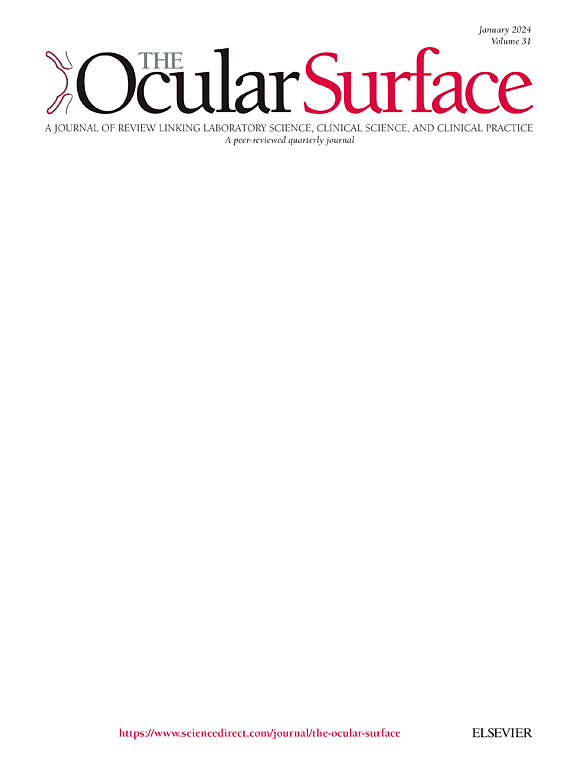Meibomian gland lipid alterations and ocular surface sequela in Awat2 knockout murine model of meibomian gland dysfunction and evaporative dry eye disease
IF 5.9
1区 医学
Q1 OPHTHALMOLOGY
引用次数: 0
Abstract
Purpose
There is an urgent need for animal models of meibomian gland dysfunction (MGD) and evaporative dry eye disease (EDED) to understand their pathophysiology and investigate novel therapeutics. This study sought to further define the acyl-CoA: wax alcohol acyltransferase 2 knockout (Awat2 KO) mouse as a model of EDED using a combination of novel clinical, biochemical, and biophysical endpoints.
Methods
Wildtype and Awat2 KO mice between 1 and 18 months of age were used. Ocular examinations and advanced imaging were performed. The lipidomic composition and in situ melting temperature of meibum were determined. qPCR was performed to define ocular surface gene and pro-inflammatory transcript expression. Dynamic contact angle goniometry was performed to assess the adherence capability of the ocular surface.
Results
Awat2 KO mice have mild, white, hyperreflective corneal opacities of the anterior stroma and significantly enlarged apical epithelial cells (P = 0.0004). In Awat2 KO meibum, wax esters were 9–10 times lower than in wildtype meibum. Additionally, meibum melting temperature increased from 32° to 47 °C (P < 0.0001), leading to impaired meibum secretion and dilation of the central duct. Awat2 KO corneal epithelia had significantly decreased mucin expression (Muc1 and Muc4, P = 0.0043) and increased interferon-γ production (P = 0.0303). Awat2 KO globes have a significantly shortened time of droplet adherence to their ocular surface (P = 0.0053), indicating a decreased tear film adherence capacity. Wildtype corneal epithelia does not express Awat2, indicating that the EDED phenotype is secondary to the loss of Awat2 from the meibomian glands.
Conclusions
Awat2 KO mice recapitulate many of features of human MGD and EDED, representing a model to test novel therapeutics.
Awat2基因敲除小鼠睑板腺功能障碍和蒸发性干眼症模型的睑板腺脂质改变和眼表后遗症。
目的:目前急需建立睑板腺功能障碍(MGD)和蒸发性干眼症(EDED)的动物模型,以了解其病理生理学并研究新型疗法。本研究试图结合新的临床、生化和生物物理终点,进一步确定酰基-CoA:蜡醇酰基转移酶 2 基因敲除(Awat2 KO)小鼠作为干眼症的模型:方法:使用 1 到 18 个月大的野生型和 Awat2 KO 小鼠。进行了眼部检查和高级成像。通过 qPCR 确定眼表基因和促炎转录物的表达。采用动态接触角测角法评估眼表的粘附能力:结果:Awat2 KO小鼠的前基质有轻度、白色、高反射性角膜不透明,角膜顶端上皮细胞明显增大(P=0.0004)。Awat2 KO 卵膜中的蜡酯含量比野生型卵膜低 9-10 倍。此外,咀嚼液的熔化温度从32°升至47°C(PConclusions:Awat2 KO小鼠再现了人类MGD和EDED的许多特征,是一种测试新型疗法的模型。
本文章由计算机程序翻译,如有差异,请以英文原文为准。
求助全文
约1分钟内获得全文
求助全文
来源期刊

Ocular Surface
医学-眼科学
CiteScore
11.60
自引率
14.10%
发文量
97
审稿时长
39 days
期刊介绍:
The Ocular Surface, a quarterly, a peer-reviewed journal, is an authoritative resource that integrates and interprets major findings in diverse fields related to the ocular surface, including ophthalmology, optometry, genetics, molecular biology, pharmacology, immunology, infectious disease, and epidemiology. Its critical review articles cover the most current knowledge on medical and surgical management of ocular surface pathology, new understandings of ocular surface physiology, the meaning of recent discoveries on how the ocular surface responds to injury and disease, and updates on drug and device development. The journal also publishes select original research reports and articles describing cutting-edge techniques and technology in the field.
Benefits to authors
We also provide many author benefits, such as free PDFs, a liberal copyright policy, special discounts on Elsevier publications and much more. Please click here for more information on our author services.
Please see our Guide for Authors for information on article submission. If you require any further information or help, please visit our Support Center
 求助内容:
求助内容: 应助结果提醒方式:
应助结果提醒方式:


